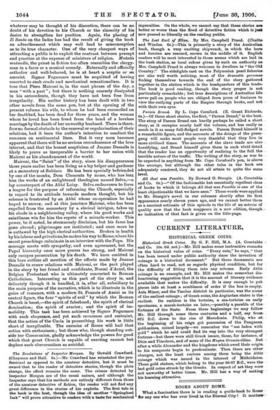CURRENT LITE RAT URE.
HISTORICAL GREEK COINS.
Historical Greek Coins. By G. F. Hill, M.A. (A. Constable and Co. 10s. 6d. net.)—Mr. Hill makes some instructive remarks on the historical value of coins. "Every coin," he says, " that has been issued under public authority since the invention of coinage is a historical document." But these documents are often hard to read, not as regards physical condition, but for the difficulty of fitting them into any scheme. Early Attic coinage is an example, and Mr. Hill makes the somewhat dis- heartening suggestion that it is the amount of literary evidence available that makes the difficulty. It is easy enough to put pieces into at least a semblance of order if the box is empty. Asia Minor, and the Tmolus district in particular, was the scene of the earliest coinage ; of Greek coins, the Aeginetan stater is the, earliest. Its emblem is the tortoise, a sea-tortoise on early specimens, a marsh-tortoise on later,—possibly a parable of the fortunes of the State. From these beginnings we may follow Mr. Hill through some three centuries and a half, say from, 675 B.C. down to the rise of Macedonia. Philip, who at the beginning of his reign got possession of the Pangaean gold-mines, coined largely—we remember the " ass laden with gold" which he said could find its way into the very strongest fortress—but there were still Greek issues, those, for instance, of Dion and Timoleon, and of some of the Magna Graecia cities. But after a while Alexander and the kingdoms which owed their origin to his conquests begin to predominate. Then there are other changes, not the least curious among them being the Attic coinage which was issued in the interest of Mithridates. These gold staters, which belong to the year 88-87 B.C., were the last gold coins struck by the Greeks. In respect of art they were- not unworthy of better times. Mr. Hill has a way of making his learning attractive.


























































 Previous page
Previous page